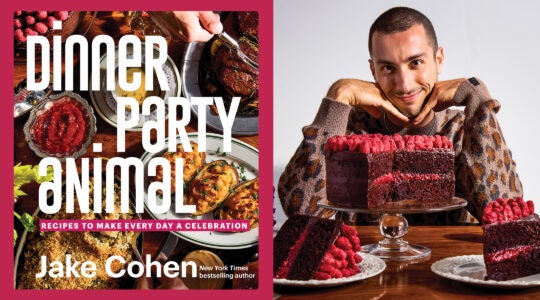When Caryn Aviv became pregnant with her daughter three years ago, she immediately decided that it was time to go “shul shopping” and began to scour Denver for a place where she would be comfortable as a Conservative-raised, openly gay, professional mom.
She instinctively tried out her local Conservative shul, where it seemed fine for her to show up alone and visibly pregnant — as long as she left any mention of her then girlfriend at home.
“It was painful to see other people’s discomfort with who I was, and not ‘get it,’” she said.
Unable to tolerate a synagogue where she couldn’t be true to herself, Aviv joined a Reconstructionist shul whose board president was openly lesbian and had recently adopted a Guatemalan boy.
“It was such a no-brainer and totally welcoming,” she said. “Every measure of inclusion and diversity actually fit how she lives her life.”
Aviv, the Posen lecturer in secular Jewish culture for the Center for Judaic Studies at the University of Denver, is the co-author of a newly released synagogue survey on “Diversity and LGBT Inclusion,” which she presented at a meeting of more than 50 Jewish community leaders, professors and congregants — many of them clad in rainbow-patterned yarmulkes — at The JCC in Manhattan last weekend. While large numbers of North American Jewish congregations say they want to include lesbian, gay, bisexual and transgender Jews in their communities, this verbal support largely fails to translate into active welcome, Aviv and her team reported.
The lack of active welcome may explain these congregations’ widespread inability to attract gay and lesbian individuals in large numbers.
The study surveyed 1,221 Jewish leaders from 997 congregations across North America and concluded that the greatest amount of LGBT support lies in the Reform and Reconstructionist and then Conservative movements, trailed significantly by the Orthodox community. Seventy-three percent of the 760 rabbis surveyed told researchers that their congregations do a good job welcoming gays and lesbians. Overall, 47 percent of the rabbis said that their views toward gays and lesbians have shifted favorably in the past 10 years: 40 percent of Reform, 60 percent of Conservative and 43 percent of Orthodox rabbis.
“The organized Jewish community is moving from rejection to tolerance to embracing,” said program participant Paul Golin, who serves as the associate executive director of the Jewish Outreach Institute. “I think that the Conservative movement is the most interesting to watch right now because they’re in the middle, and they’re struggling between embracing and tolerating.”
Despite the positive survey responses among Jewish clergy, only 33 percent of these same rabbis said that their synagogues offer LGBT-related programs, such as events about marriage equality. Many of these communities would be happy to welcome LGBT members, but they face difficulty recruiting the “first” person when they have no preexisting programs, according to Golin.
“They feel like they’re in a Catch-22,” he told participants in the conference, which was hosted jointly by The Institute for Judaism and Sexual Orientation at HUC and Jewish Mosaic, a project of Jewish Funds for Justice based in Denver.
“Getting the warm bodies into the congregations makes the difference because then it’s part of everyday life,” Aviv said.
Another obstacle to full-fledged welcome is the misconception that gay Jews prefer to pray in an LGBT synagogue rather than a mainstream congregation.
“Not every gay person wants to go to a gay shul,” Aviv said.
Many synagogue leaders also fear that if they welcome gay and lesbian congregants, they might lose members who oppose LGBT inclusion, according to co-author Steven M. Cohen, who is a research professor of Jewish Social Policy at Hebrew Union College-Jewish Institute of Religion. But in the survey, 41 percent of rabbis whose congregations proactively reached out to gay and lesbian Jews reported gaining members as a result, and only two percent reported losing members, he said.
Some ways for congregations to become more welcoming include posting rainbow flag stickers in windows, actively fighting for state marriage equality and designating unisex bathrooms for the comfort of transsexual and queer Jews, according to Aviv, Cohen and Rabbi Rebecca Alpert, an associate professor of religion and women’s studies at Temple University. Other methods include using the word “partner,” rather than spouse, on the bima and showing children films that include gay characters, said Idit Klein, the executive director of Keshet LGBT advocacy group.
“As long as the reality of our existence is viewed as inappropriate for children, then we have a long way to go,” said Klein, who was the executive producer of the documentary film “Hineni: Coming Out in a Jewish High School.”
“Hospitality, if it is to work, really has to be in the DNA of the congregation,” said the Reverend Steve Clapp, president of the nonprofit research program Christian Community, a Protestant group that many point to as a model for the Jewish community on gay inclusion. Clapp emphasized the need for continued sermons, LGBT-related classes and interactive group work as a mode toward inclusion.
In one of the largest Protestant denominations — the United Church of Christ — 780 congregations are LGBT-friendly, and clergy members will often refuse jobs at churches that are not actively “open and affirming,” according to the Reverend Ruth Garwood, the executive director of The United Church of Christ Coalition for Lesbian, Gay, Bisexual and Transgender Concerns.
“It’s the difference between knowing that you’re loved and being told that you’re loved,” she said.
The New York Jewish Week brings you the stories behind the headlines, keeping you connected to Jewish life in New York. Help sustain the reporting you trust by donating today.




